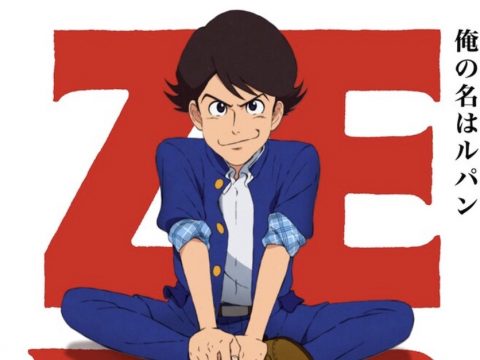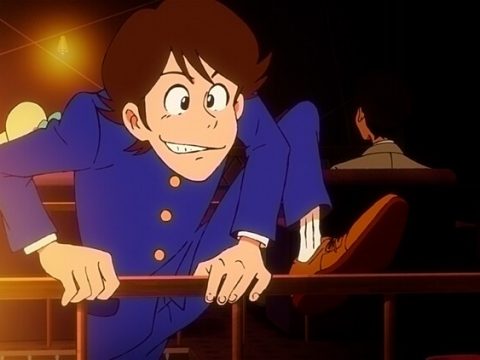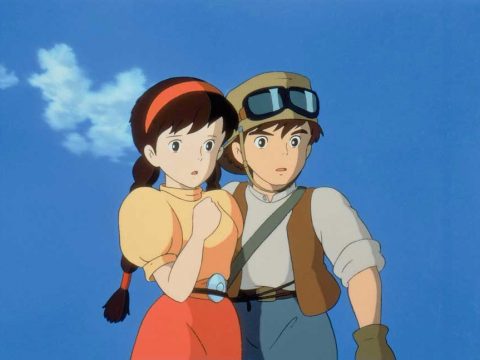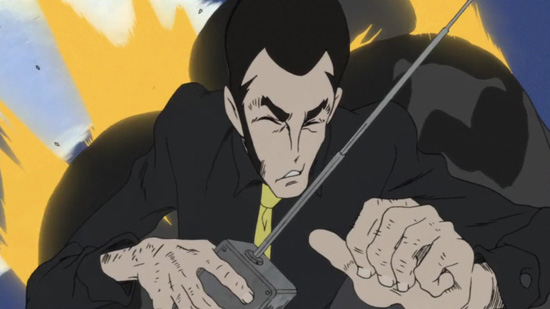
Four years ago, back in 2008, first-time anime series director Sayo Yamamoto debuted with Michiko and Hatchin, a phenomenal television show with solid characterization and a distinct visual and aural style that in my mind seemed like a no-brainer for US release. I was certain there would be Blu-Rays and maybe even a television run targeted at the same people who watched Cowboy Bebop and Samurai Champloo. Sayo Yamamoto embodies two of the rarest traits possessed by directors of Japanese animation. The first is that Sayo Yamamoto is under 40 years old. Although many of the current veterans of the industry got their starts directing films and television shows back when they were in their 20s, such a thing is practically unheard of in the modern risk-averse economy. Even directors considered “newcomers” or “the future of the industry” like Mamoru Hosoda (Summer Wars) or Masaaki Yuasa (Mind Game) are already in their mid-40s. The second, even rarer, trait is that unlike nearly every other notable anime director whom I and the majority of people without the aid of the Internet can think of, Sayo Yamamoto… is a lady.
But Michiko and Hatchin never did come out in America, and Yamamoto’s “reward” for a job well done was to effectively be sent “back in the trenches.” I’ve noticed anime has a tendency to do that with its first-time directors who make impressive debuts on longer-form works. Takeshi Koike spent years on Redline, which upon completion spent what seemed like forever making the rounds at international film festivals before finally being released in the US a few months ago. Hiroyuki Okiura did a heck of a job on Jin-Roh: The Wolf Brigade, and never got tasked to direct anything again for years. Fortunately, the hope bird’s out of the box. Okiura’s second film, A Letter to Momo, was finally released in Japanese theaters (after debuting at international film festivals and remaining yet unlicensed for US release…), and while Koike’s next directorial effort is yet to be announced, he’s on board for the second anime TV series to be directed by Sayo Yamamoto: the fourth Lupin the Third television series!
Lupin the Third: The Woman Called Fujiko Mine marks the 40th anniversary of Lupin anime, and much like Episode 0: First Contact, this is a “right before the gang got together” tale… only this time, the main character isn’t the world’s greatest thief, Arsene Lupin the Third. In fact, in almost Mamoru Oshii-like fashion, Lupin hasn’t even shown up in half of the episodes that have aired to date! The main character this time is thief and lady spy extraordinaire, Fujiko Mine. Contrary to the old FUNimation dubs, that’s pronounced more like “mee-nay” than an explosive or a place you’d extract ore. Fujiko’s had her share of stories focused on her over the years, but her primary role is to serve as a foil to the other characters. That’s still the case here, but this is unlike most Lupin media you’re likely to have experienced. In fact, it isn’t quite like any Lupin made to date, period.
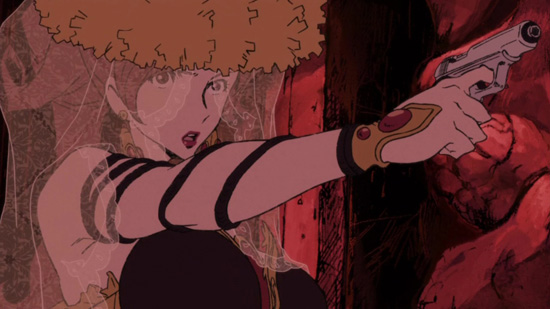
For in making this series, the approach to handling these iconic characters has been to take them back to their original roots… and in so doing, take them into brand-new territory. Chances are likely that if you’re even aware of the Lupin Gang at all, it’s due to either the Adult Swim partial broadcast of the second TV series or the theatrical film The Castle of Cagliostro directed by Hayao Miyazaki, now of Studio Ghibli renown. Nearly all of the subsequent Lupin anime made to date has drawn upon those sources as their primary inspiration regarding how the characters behave and interact, but that is not where The Woman Called Fujiko Mine takes most of its inspiration. The shadow of Cagliostro casts far, so far that there seems to be no limit to the amount of events that transpired “back when I was just starting out, before I met all of you guys” that tend to culminate in some sort of double-cross or near-death experience. But this anime takes most of its cues from two sources: the first half of the original 1970s Lupin the Third anime series set for US release in just a few months, and the original 1960s manga by series creator “Monkey Punch,” which was actually released in English a decade ago by Tokyopop in the US.
Describing exactly WHAT aspects from the manga carry over to this series is tricky, since other than a few key visual elements and—ahem—positions, there are no direct similarities. Were that the case, I wouldn’t like this show as much as I do. I remember buying the volumes of that manga bimonthly as they were released, but after seven volumes, $70 plus tax, and roughly a year and a half of waiting for the comic to begin resembling what I’d seen in the anime to no avail, I gave up on it. The artwork was so sketch-like in places that I couldn’t reliably tell the gunslinger Jigen Daisuke apart from other characters who happened to have a beard and hat. Figuring out just what I was actually seeing was a challenge, and the lack of characterization didn’t help clear matters up in that regard either. What’s more, Fujiko seemed to get sexually assaulted multiple times per chapter. Or perhaps they were different women with near-identical faces and figures. I couldn’t tell.
Thanks to character designs and animation direction by Takeshi Koike, Lupin the Third: The Woman Called Fujiko Mine doesn’t have any of the visual communication issues I had with the early volumes of the original manga. Indeed, the look of the series makes it the standout of an unusually strong season of anime currently airing on Japanese television. Rather than inject a dose of his Peter Chung and Yoshiaki Kawajiri-influenced aesthetic, Koike’s designs of the cast is effectively a combination of how the characters looked in the manga with the original TV show. The characters are unmistakable yet have a unique edge to them, with a shading method that I can best describe as reminiscent of Gankutsuou or the original Valkyria Chronicles on PS3: the shadows—typically a series of straight, thick black lines—remain relatively static as the characters move, as if they were stenciled outlines.
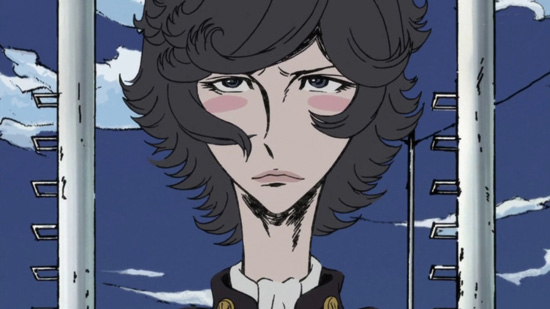
The striking visuals make it easier to accept the fact that the main thing inherited from the manga by this television series is its overall tone. The humor and action are still present, but the breezy lightheartedness has been replaced by something far more callous and mean than what you may be accustomed to seeing from Lupin the Third in anime form. For instance, the very first chapter of the manga was about Lupin stealing microfilm—this is decades before From Eroica with Love, folks—from a professor who opted to hide it inside one of his daughters, if you get my drift. That specific event has yet to occur in The Woman Called Fujiko Mine, and the fact that Fujiko is now the central character means that she’s not getting routinely backhanded down before being pounced upon, but that’s the sort of space in which these stories occupy. In terms of violence the series is almost entirely bloodless, but the approach to sexuality resembles that of the original James Bond tales that greatly inspired the creation of Lupin the Third to begin with.
Most discussions of Lupin the Third: The Woman Called Fujiko Mine begin, end, and focus almost exclusively on the nudity/sexuality aspects, which are certainly present in much higher quantities than most modern television fare. That much is immediately obvious, as the opening credits are a surreal European-themed montage where Fujiko is fully nude with breasts bared a la Belladonna of Sadness, the final film of Mushi Productions’ Animerama trilogy. But this fourth Lupin TV series has been airing in Japan for roughly a month now, and quite frankly I feel there’s more to talk about here than just arguing over whether or not such content directly inspired by 1960s/1970s-era source material is acceptable for the modern era. At the same time, there’s no way around it: Fujiko Mine does indeed spend a significant amount of time with her breasts fully exposed to the camera in this cartoon. She uses her body to manipulate others and extract information in a manner akin to the female spy Mylene Hoffman from the rather overlooked 009-1, which entails a fair amount of sex and seduction. If you have objections to the handling of such content of one, then you will almost assuredly have the same objections to the other. Indeed, there is little shortage of vocal critics in this regard, and their positions are valid ones. But the inverse is also true, as both Lupin and 009-1 started in the same year and were originally published in the same anthology. The two aren’t identical, but they share some common ancestry such that it’s quite likely that fans of ones will enjoy the other too. Come to think of it, the 009-1 anime was made roughly 40 years after its series began, too! Plus, as with Lupin, you can watch that series streaming courtesy of FUNimation, as well.
Unlike fanservice-heavy anime titles such as Queen’s Blade, all of that stuff is a means rather than the end itself. Good thing, too, because the novelty factor of cartoon boobies only goes so far. What keeps a long-time fan such as me tuning in to Lupin the Third: The Woman Called Fujiko Mine each week is seeing how these iconic characters have been changed in comparison and contrast to what’s come before. Some don’t seem too different from how they’ve been portrayed in the past. Others are almost completely unrecognizable. Will the events of this series change them to resemble their iconic states? Or does it even matter, considering that the characters are ageless and all Lupin the Third stories are standalone tales without any strict continuity binding them together? Indeed, for quite a few fans that are watching the streams on FUNimation’s website, this series marks their very first time seeing Lupin, Jigen, Fujiko, Goemon, and Zenigata. They’re not riding any nostalgia wave brought on by pachinko slot machine manufacturers. They’re engaging with Lupin as a stylish piece of action entertainment set in a world slightly exaggerated from our own with content that’s a bit risqué compared to conventional fare. In other words, like how audiences back in the 1960s and 1970s reacted to it.
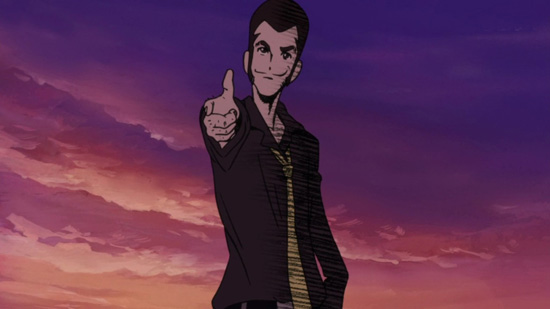
After four episodes, the cast has still yet to all meet one another. In the past, initial meetings between Jigen, Lupin, and Goemon arose due to assassination attempts, but for now only Fujiko has individually gotten in contact—often in more ways than one—with each member of the cast. That includes a brand new addition created for this series: Zenigata’s partner, Oscar. Oscar looks, dresses, and behaves completely differently from any other character in the series, resembling a classic shojo protagonist in both looks and demeanor. Translation: Oscar is a rather androgynous sort who is completely hostile to women while harboring implied romantic feelings for Inspector Zenigata. The ambiguous design combined with the fact that the character’s name is “Oscar” invites direct comparison to the shojo classic The Rose of Versailles, in which the lead character is born female but named “Oscar” and raised as a man. Is the same thing going on here? Why add this character to the cast of Lupin the Third in the first place? Zenigata has been paired with partners a few times in the past, but they typically don’t stick around too long for one reason or another…
New Lupin the Third feature-length TV movies have been getting made once a year since the 1990s, and while some are “fantastic” and nearly all are “enjoyable,” over the years they’ve fallen into something of a formulaic holding pattern. As decades of stories accumulate, it becomes progressively harder to remember that once upon a time, there were no “rules” or “patterns” to these tales. There didn’t always HAVE to be a young girl in distress, or a secret evil organization that’s been ruling the world from the shadows, or all that other stuff that’s now become “standard.” For the 40th anniversary of the anime, Sayo Yamamoto et al could have easily adhered to convention and filled in the blanks, but with The Woman Called Fujiko Mine they’ve delivered a wake-up cry that says “you don’t have to start incorporating time travel, genies, space aliens, alternate parallel realities, or the cast of Case Closed in order to make these characters seem fresh again. You don’t have to have the typewriter-written episode titles. You don’t have to show every character doing their trademark thing every single time. All you have to do is STOP PLAYING IT SO SAFE.”
That’s exactly what they’ve done, and it’s working. I’m watching this one to the end.
Watch Lupin the Third: The Woman Called Fujiko Mine on
FUNimation’s streaming site
Original comic books created by Monkey Punch ©TMS.
Licensed by FUNimation® Productions, Ltd. All Rights Reserved.


